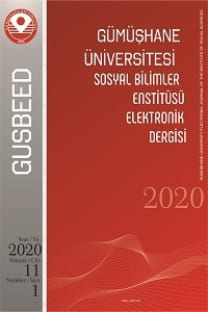Gelişmekte Olan Teknolojiler Sonucu Sağlıkta Oluşacak Yeni Meslekler
Sağlık Hizmetleri, Tıp, Teknoloji, Meslekler
New Professions in Healthcare as a Result of Emerging Technologies
Healthcare, Medicine, Technology, Professions,
___
Chung, A. E., Griffin, A. C., Selezneva, D., & Gotz, D. (2018). Health and Fitness Apps for Hands-Free Voice-Activated Assistants: Content Analysis. JMIR mHealth and uHealth, 6(9), e174. doi:10.2196/mhealth.9705Das, R.(2018). 10 Future Healthcare Jobs To Watch https://www.forbes.com/ sites/reenitadas/2018/01/03/10-future-healthcare-jobs-towatch/#288720842032
Gatouillat, A., Badr, Y., Massot B. and Sejdić E. (2018). Internet of Medical Things: A Review of Recent Contributions Dealing With Cyber-Physical Systems in Medicine, in IEEE Internet of Things Journal, vol. 5, no. 5, pp. 3810-3822, Oct. 2018. doi: 10.1109/JIOT.2018.2849014
Goyal, M.R., Goyal, V.K. (2014). Biomechanics Of Artifıcial Organs And Prostheses, Apple Academic Press, 978-1-4822-3157-1
Hasan, A. (Ed.) 2017.Tissue Engineering for Artificial Organs: Regenerative Medicine, Smart Diagnostics and Personalized Medicine, Volume 1, 978-3-527-33863-4, WILEY-VCH Verlag GmbH & Co. KGaA, Weinheim
Hooijdonk, R. V. (2016). From organ implant designer to medical roboticist – 8 healthcare jobs of the future https://www.richardvanhooijdonk.com /en/blog/organ-implant-designer-medical-roboticist-8-healthcare-jobs-future/
Mayahi A. S., Badi A. A., Tarhini A. (2018). Exploring the Potential Benefits of Big Data Analytics in Providing Smart Healthcare. In: Miraz M., Excell P., Ware A.,
Soomro S., Ali M. (eds) Emerging Technologies in Computing. iCETiC 2018. Lecture Notes of the Institute for Computer Sciences, Social Informatics and Telecommunications Engineering, vol 200. Springer, Cham
McDonald, C. (2017). 5 Big Data Trends in Healthcare for 2017, MapR, https://mapr.com/blog/5-big-data-trends-healthcare-2017/
Miotto, R., Wang, F., Wang, S., Jiang, X., Dudley, J.T. (2018). Deep learning for healthcare: review, opportunities and challenges, Briefings in Bioinformatics, Volume 19, Issue 6, 27 November 2018, Pages 1236–1246, https://doi.org/10.1093/bib/bbx044
Liston, P.O. (2012). The First Artificial Heart, 30 Years Later, https://healthcare. utah.edu/healthfeed/postings/2012/12/120212ArtificialHeart30YearsLater.php
Love, B. (2017). Biomaterials: A Systems Approach to Engineering Concepts, Chapter 14: Artificial Organs. Pages 337-360 https://doi.org/10.1016/B978-0-12-809478-5.00014-6
Lysaght, M., Webster, T.J (Ed.) 2011. Biomaterials for artificial organs, Woodhead Publishing Limited. 978-0-85709-084-3
Panesar, A. (2019). Machine learning and AI for healthcare: Big data for improved health outcomes. Coventry, UK: Apress.
Reinsel, D., Gantz, J., Rydning, J. (2018). Data Age 2025, sponsored by Seagate with data from IDC Global DataSphere, Nov 2018
https://www.seagate.com/files/www-content/our-story/trends/files/idc-seagate-dataage-whitepaper.pdf Erişim Tarihi: 25.07.2019
Segal, S. (2017). Controlling Critical Risks in Healthcare. International Journal of Computer Trends and Technology, 48(1), 24-26. doi:10.14445/22312803/ijctt-v48p106
Sennaar, K. (2019). Artificial intelligence in Telemedicine and Telehealth – 4 Current Applications. https://emerj.com/ai-sector-overviews/artificial-intelli gence-in-telemedicine-and-telehealth/
Tibben, W., & Wamba, S. F. (2018). Exploring the potential of big data on the health care delivery value chain (CDVC): A preliminary literature and research agenda. Proceedings of the 51st Hawaii International Conference on System Sciences. doi:10.24251/hicss.2018.356
www.jarvikheart.com/history/robert-jarvik-on-the-jarvik-7/
www.mercyvirtual.net/
www.peakwellnessgroup.com/epigenetics
www.tdk.gov.tr
Vittori, J. (2018). Applications of Augmented Reality In the Healthcare Industry and Its Impact on Surgical Outcomes https://www.healthworkscollective.com/ augmented-reality-in-healthcare-its-impact-on-surgical-outcomes
- ISSN: 1309-7423
- Yayın Aralığı: Yılda 3 Sayı
- Yayıncı: Gümüşhane Üniversitesi
Turizm Teşvik ve Desteklerinin Paydaşların Bakış Açısıyla Değerlendirilmesi
Ayhan KARAKAŞ, Ahmet ASLAN, Şaban ESEN
Üniversite Tercihlerinde Prestij, Deneyim ve Kulaktan Kulağa İletişimin Etkisi
Turizm Yatırımının Turizm Gelişimi ve Çevre Kalitesi Üzerindeki Dinamik Rolü
Hasan AYAYDIN, Alper Veli ÇAM, Abdulkadir BARUT, Fahrettin PALA
Bağımsız Denetim Kalitesinin Muhasebe İhtiyatlılığı Üzerindeki Etkisi: BİST’te Bir Araştırma
Sürdürülebilir Turizm Gelişimi ve Yaratıcı Turizm
Üzeyir KEMENT, Sinan ÇAVUŞOĞLU, Aziz BÜKEY, Berkan BAŞAR
Fazıl KAYA, Sema KÜÇÜKALİ, İsmail KIZILIRMAK
